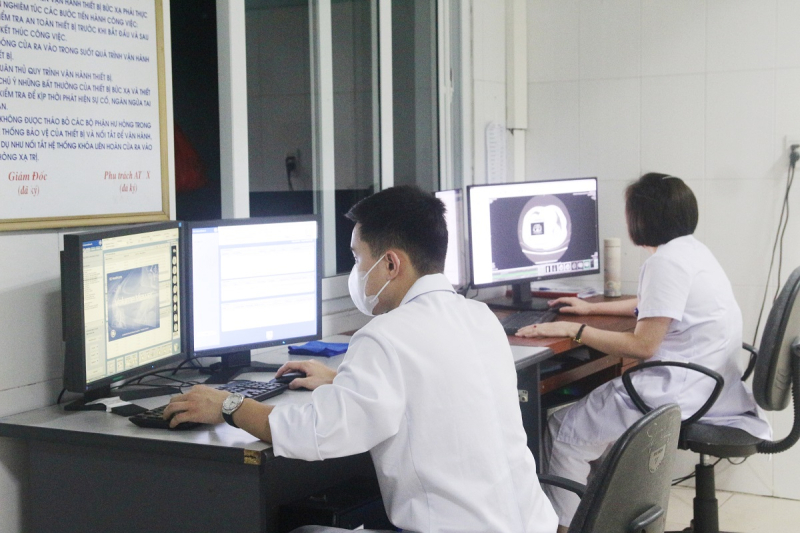Digital transformation of healthcare is one of the top priority areas in the National Digital Transformation Program and the comprehensive digital transformation of Quang Ninh province by 2025, with a vision to 2030. Recognizing the importance of this content, in recent times, the provincial health sector has actively applied advances in science and technology (S&T), information technology (IT) to bring great convenience to professional work, especially in medical examination, treatment, and health care for the people.

Before comprehensive digital transformation became a major orientation implemented in all sectors and fields, the Quang Ninh Health sector proactively took a step forward, applying IT and science and technology platforms to bring benefits to patients as well as improve the quality of operations of medical facilities. In particular, the most obvious mark was the investment in building smart hospitals at Bai Chay Hospital, the Provincial General Hospital and the Obstetrics and Pediatrics Hospital from 2017 and completed in 2020.
With the smart hospital model, the professional and technical activities of hospitals have been computerized and implemented on a computer network environment. The hardware infrastructure has been invested quite fully, such as: Server system, workstation; system connecting all devices; barcode reader system, online payment of medicine and hospital fees... The system of specialized software, such as: Hospital management software, image data transfer software, software for receiving and returning test results... are also well applied to help simplify and shorten the time for administrative procedures, improving the quality of service for patients.
Currently, people who need to see a doctor at the above hospitals, just need a mobile device connected to the internet, have the Zalo application or a web browser, people anywhere can proactively make an appointment, choose a suitable date and time at the hospital without having to wait in line, helping to overcome the congestion due to patient overload during peak hours, helping people to proactively schedule their visits, increasing the time for contact between doctors and people. Along with that, the non-cash online payment solution has also been deployed by hospitals to help people pay for medical services and hospital fees quickly and accurately.
In particular, Bai Chay Hospital, the Provincial General Hospital and Quang Ninh Obstetrics and Pediatrics Hospital are among the 10 hospitals nationwide recognized by the Ministry of Health as meeting the criteria for electronic medical records, thereby helping patients avoid having to store all types of documents when going to see a doctor or receive treatment, such as diagnosis results, tests, drug lists, etc.
Ms. Le Thuy An (Gieng Day Ward, Ha Long City) is being treated at Bai Chay Hospital, shared: Thanks to the electronic medical record, I do not have to worry about losing the test results, and can easily compare each test index and the results of periodic general health check-ups. Along with that, I can also manage my health information continuously, throughout my life, store my family history, medical history, and drug allergy history more fully, proactively prevent diseases, and take care of my health and that of my family.

Along with the solid foundation of the smart hospital model, the mark of actively and proactively applying scientific and technological advances and information technology to the activities of the health sector is also clearly demonstrated in the implementation of the project "Application of science and technology to remote consultation, consultation, examination and treatment at facilities in Quang Ninh province" (Telemedicine). The province is the first locality in the country to deploy a synchronized Telemedicine system to the district level.
To date, 100% of provincial and district health units are equipped with a system with 31 points, including 10 points located in operating rooms. Thanks to Telemedicine, the health sector has conducted hundreds of consultations, consultations and treatment instructions for difficult cases from central hospitals to provincial hospitals and from provincial hospitals to district hospitals; promptly deployed online meetings, helping to direct and operate disease prevention and control, natural disaster prevention and control, and support professional training...
Along with the early and proactive application of IT from the grassroots level, in the process of digital transformation that is being strongly implemented, the provincial health sector is also continuing to promote the application and upgrading of software and utilities, perfecting the criteria for paperless hospitals, with the highest goal of bringing convenience to serve the people. Currently, hospitals and medical facilities in the province are upgrading medical examination and treatment information management software (HIS/LIS/PACS/EMR); upgrading the Medical Information Management System and Medical Examination and Treatment at the commune and ward levels; connecting medical examination and treatment data and health insurance payment with the Vietnam Social Security appraisal portal, national prescriptions and the province's electronic health records.
Deploying digital transformation on the application platform of the National Population Database according to Project 06, the provincial health sector also quickly deployed health insurance examination and treatment using chip-embedded CCCD cards to replace health insurance cards and data connection. Currently, medical units continue to promote and diversify communication methods for people participating in health insurance about using CCCD when going for medical examination and treatment instead of health insurance cards; allocating funds, proactively purchasing quality equipment, meeting technical standards issued by the Ministry of Information and Communications to read CCCD information or VNEID application.
The entire sector also initiated and updated initial data for nearly 1.39 million people on the Quang Ninh province Electronic Health Record software. At the same time, all 12 medical facilities licensed to issue driver health certificates have connected with the National Public Service Portal system, deploying public services at level 4...
Source



![[Photo] Prime Minister Pham Minh Chinh chairs the meeting of the Government Party Committee Standing Committee](https://vstatic.vietnam.vn/vietnam/resource/IMAGE/2025/8/23/8e94aa3d26424d1ab1528c3e4bbacc45)

![[Photo] General Secretary To Lam attends the 80th Anniversary of the Cultural Sector's Traditional Day](https://vstatic.vietnam.vn/vietnam/resource/IMAGE/2025/8/23/7a88e6b58502490aa153adf8f0eec2b2)












































































Comment (0)